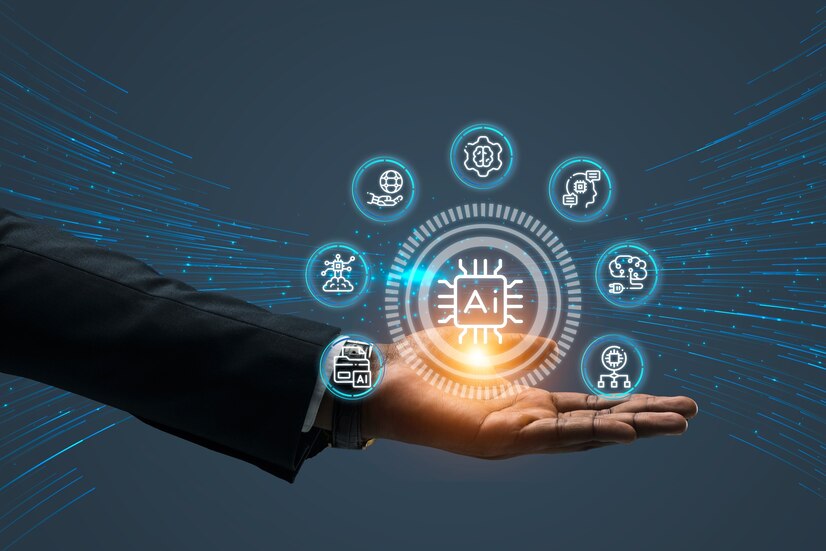The Future Of Work: How Automation And AI Are Changing The Job Market
by Abdul Aziz Mondal Technology Published on: 22 February 2024 Last Updated on: 25 September 2024

The rapid advancement of technology, particularly automation and artificial intelligence (AI), is transforming the global workforce. As machines take on tasks once exclusive to humans, the nature of work and necessary skills are evolving rapidly.
This article examines how automation and AI impact the job landscape, as well as the challenges and opportunities ahead. You will also discover strategies for individuals, businesses, and governments to navigate this paradigm shift.
The Rise Of Automation And AI
Artificial intelligence has been doing wonders not only in a particular sector but many more. One classic example is in automation. Read to know how AI takes the edge of automation and fosters growth:

The Disruptive Force Of Automation
Automation has been a driving force behind industrial revolutions throughout history. Thus, replacing manual labor with machines and streamlining processes across various sectors. Today, automation continues to reshape industries, from manufacturing and transportation to agriculture and customer service.
Robotic systems and automated processes are becoming increasingly sophisticated. Not only are they capable of performing intricate tasks with precision and efficiency, but also outpacing human capabilities. Especially in terms of speed and consistency.
The Advent Of Artificial Intelligence
Artificial intelligence (AI) is a game-changing technology that enables machines to mimic human intelligence and learn from data. Further, they also make decisions based on complex algorithms.
AI has already found applications in fields such as healthcare, finance, and marketing. They typically revolutionize how we diagnose diseases, make investment decisions, and personalize customer experiences.
As AI continues to advance, its impact on the job market is expected to be profound. Machines are potentially taking over roles that require cognitive abilities, pattern recognition, and decision-making.
Job Displacement And The Changing Nature Of Work
No work ever is constant! With the incoming trends of AI and technologically advanced technologies, human jobs are at risk. But as much they are true, there’s some myth in it. Here’s how you can find new opportunities to save jobs and work hand in hand with automation.
Jobs At Risk Of Automation

While automation and AI promise increased productivity and efficiency, they also pose a risk to certain jobs, particularly those involving routine, repetitive tasks.
Industries such as manufacturing, transportation, and administrative services are among the most vulnerable to automation-driven job displacement.
However, even roles that were once considered safe from automation, such as accounting or legal work, are now being impacted by AI-powered software and algorithms.
The Rise Of New Job Opportunities
Even as some jobs become obsolete, the advent of automation and AI is creating new employment opportunities. Industries such as robotics, cybersecurity, data analysis, and AI development are experiencing rapid growth. They are demanding a skilled workforce proficient in programming, machine learning, and data science.
Additionally, jobs that require uniquely human skills, such as creativity, emotional intelligence, and critical thinking, are likely to remain in high demand. Again because machines struggle to replicate these abilities fully.
Upskilling And Reskilling For The Future
Gone are the days when a particular tool did one specific job. This is the age of multitasking, constant experiments, and achieving success. Unless you don’t master the art of multitasking with the use of AI tools, there’s no way to upskill yourself for the future!
Embracing Lifelong Learning
In the face of rapid technological change, individuals must embrace a mindset of lifelong learning and continuous skill development. Reskilling and upskilling have become essential strategies for staying relevant and employable in the ever-evolving job market.
Professionals should seek out opportunities to acquire new skills, whether through formal education, online courses, or on-the-job training, to remain competitive and adaptable.
Soft Skills And Human-Centered Competencies

While technical skills are crucial, the future job market will also place a premium on soft skills and human-centered competencies. Qualities such as critical thinking, problem-solving, creativity, communication, and emotional intelligence will be highly valued.
The reason is machines struggle to replicate these uniquely human traits. By cultivating these skills, individuals can position themselves for roles that require human expertise, judgment, and interpersonal abilities. Undeniably, complements the strengths of AI and automation.
The Role Of Governments And Organizations
You are highly mistaken if you think that the governing bodies of a city, state, or country have nothing to do with growing job opportunities for people. Actually, it is due to these bodies that the future of jobs looks bright. Here’s how!
Educational Reform And Workforce Development
Governments and educational institutions play a pivotal role in preparing the workforce for the future of work. Educational curricula must be revised to incorporate the skills and knowledge necessary in the age of automation and AI. For example, coding, data science, and digital literacy.
Additionally, workforce development programs and vocational training initiatives should be implemented. The goal is to reskill and upskill workers whose jobs are at risk of displacement.
Fostering Innovation And Entrepreneurship
Encouraging innovation and entrepreneurship can help drive economic growth and create new job opportunities in the face of technological disruption.
Governments and organizations should support startups, small businesses, and entrepreneurs who are developing innovative solutions and creating jobs in emerging industries.
This could involve initiatives such as access to funding programs, tax incentives, incubator programs, and fostering a culture of risk-taking and creativity.
For entrepreneurs in need of quick capital to get their ventures off the ground or bridge temporary cash flow gaps, private options like CreditNinja quick loans can be explored.
These online lenders offer fast approval and funding processes for small business loans, which can be invaluable for seizing time-sensitive opportunities or addressing urgent financial needs. Of course, responsible borrowing practices should be exercised with any loan product.
Ethical Considerations And Responsible AI

Addressing Bias and Algorithmic Fairness
As AI systems become more prevalent in decision-making processes, it is crucial to address the issue of bias and algorithmic fairness. AI algorithms can inadvertently perpetuate and amplify societal biases, leading to discrimination and unfair treatment in areas such as hiring, lending, and criminal justice.
There should be efforts to develop ethical AI frameworks and ensure transparency and accountability. Further, it must also be able to promote responsible AI practices that respect human rights and promote inclusivity.
The Human-Machine Symbiosis
Rather than viewing automation and AI as a threat to human labor, it is essential to foster a symbiotic relationship between humans and machines.
By leveraging the strengths of both, we can create a future where humans and AI collaborate seamlessly, with machines augmenting and enhancing human capabilities rather than replacing them entirely.
This approach requires a mindset shift, embracing the coexistence of human and artificial intelligence and finding ways to optimize their complementary abilities.
Conclusion
The future of work is being reshaped by the forces of automation and AI, presenting both challenges and opportunities. While job displacements are valid concerns, the advent of these technologies is also paving the way for new career paths.
By embracing lifelong learning, cultivating human-centric skills, and fostering responsible innovation, individuals, businesses, and governments can navigate this transition successfully.
The key lies in striking a balance between harnessing the power of technology and preserving the essential human elements. These machines cannot replicate. By doing so, we can create a future of work that is both efficient and productive. They are also fulfilling and inclusive for all.
Additional:



































































































